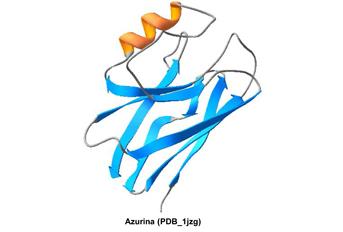Associação Portuguesa de Investigação em Cancro
Azurina, uma proteína bacteriana com acção anti-tumoral
Azurina, uma proteína bacteriana com acção anti-tumoral

O trabalho intitulado «The bacterial protein azurin impairs invasion and FAK/Src signaling in P-cadherin-overexpressing breast cancer cell models» resulta de uma investigação em parceria entre o IBB/IST e o IPATIMUP. Pretende-se contribuir para o esclarecimento acerca das propriedades anticancerígenas de uma proteína de origem bacteriana designada azurina. Esta proteína, solúvel e de baixo peso molecular (14 kDa) é sintetizada pela bactéria Pseudomonas aeruginosa. Vários estudos publicados demonstraram que a azurina entra preferencialmente em células neoplásicas, induzindo, quer in vitro quer in vivo, morte celular e o um efeito anti-angiogénico. Acresce que um péptido com 28 aminoácidos (P28) derivado da azurina, está nos EUA a ser testado em ensaios clínicos. Neste artigo, estudámos o efeito da azurina em linhas tumorais de mama que sobre-expressam a proteína membranar caderina-P, um marcador tumoral associado a um mau prognóstico em cancro da mama. Nos modelos celulares usados, os níveis da proteína Caderina-E (funcionando como fator de supressão da invasão) são mantidos estáveis. Constatámos que o tratamento das células com doses sub-letais de azurina conduziram a uma diminuição dos níveis de caderina-P (sem alteração nos níveis de Caderina-E), bem como à diminuição das formas fosforiladas (activas) do complexo FAK/Src, uma via de sinalização importante para a invasão tumoral activada pela caderina-P. Por fim verificou-se uma significativa redução da invasão celular após tratamento com a azurina. Os resultados obtidos são promissores e parecem indicar que a azurina pode vir a constituir-se como uma proteína terapêutica com acção anti-tumoral para cancros de mama com sobre-expressão da caderina-P.
Nuno Bernardes1,2, Ana Sofia Ribeiro2, Sofia Abreu1, Bruna Mota1, Rute G Matos3, Cecilia M Arraiano3, Raquel Seruca2, Joana Paredes2, Arsénio M Fialho1
1.Institute for Biotechnology and Bioengineering (IBB), Instituto Superior Técnico (IST), University of Lisbon, Portugal;
2.Institute of Molecular Pathology and Immunology of the University of Porto (IPATIMUP), Porto, Portugal;
3.Instituto de Tecnologia Quimica e Biológica (ITQB), Universidade Nova de Lisboa, Oeiras, Portugal
P-cadherin overexpression occurs in about 30% of all breast carcinomas, being a poor prognostic factor for breast cancer patients. In a cellular background of wild-type E-cadherin, we have previously shown that its expression promotes invasion, motility and migration of breast cancer cells due to the induced secretion of metalloproteases (MMPs) to the extracellular medium and to the concomitant shedding of a pro-invasive soluble form of this protein (sP-cad). Azurin is secreted by Pseudomonas aeruginosa and induces in vitro and in vivo cytotoxicity after its preferential penetration in human cancer cells relative to normal cells. Three different breast cancer cell lines, MCF-7/AZ.Mock, MCF-7/AZ.Pcad and SUM149 were treated with sub-killing doses of azurin. Invasion of these cells was measured using Matrigel Invasion Assays and MTT assays were performed to determine cell viability upon treatment and the effects on cadherins expression was determined by Western blot and Immunofluorescence. Gelatin Zymography was used to determine activity of MMP2 in the conditioned media of azurin treated and untreated cells and the phosphorylation levels of intracellular signaling proteins were determined by Western blot. The invasive phenotype of these breast cancer cells was significantly reduced by azurin. Azurin (50-100 μM) also caused a specific decrease on P-cadherin protein levels from 30-50% in MCF-7/AZ.Pcad and SUM149 breast cancer cell lines, but the levels of E-cadherin remain unaltered. More, the levels of sP-cad and the activity of MMP2 were reduced in the extracellular media of azurin treated cells and we also observed a decrease in the phosphorylation levels of both FAK and Src proteins. Our data show that azurin specifically targets P-cadherin, not E-cadherin, abrogating P-cadherin-mediated invasive effects and signaling. Therefore, azurin could possibly be considered a therapeutic tool to treat poor-prognosis breast carcinomas overexpressing P-cadherin in a wild type E-cadherin context.
Revista:
PLOS ONE
http://www.ncbi.nlm.nih.gov/pubmed/23894398




